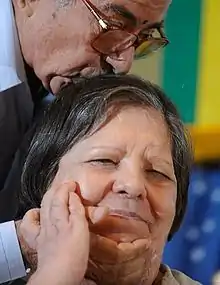Inês Etienne Romeu
Inês Etienne Romeu (December 18, 1942 – April 27, 2015) was a Brazilian political prisoner held in extrajudicial detention in a Brazilian torture camp in the early 1970s.[1][2] Romeu has been described as the sole captive to survive the camp. In 2014, Colonel Paulo Malhães testimony to the National Truth Commission revealed that Colonel of the Army Cyro Guedes Etchegoyen was the person in charge of the House of Death.[3] He was head of the Army Information Center (CIE) from 1971 to 1974. He was also in charge of a group Brazilian military sent to train Augusto Pinochet's military personnel. Colonel Etchegoyen was trained at US Army School of the Americas.[4][5] Paulo Malhães, would later claim that the purpose of the center was to convince suspected political opponents to serve as double agents against regime opponents. The main technique used to turn suspects into double agents was torture, which would be backed up by blackmail and clandestine payments.
Inês Etienne Romeu | |
|---|---|
 Brazilian torture survivor Inês Etienne Romeu reported being raped and sexually humiliated in addition to torture during her secret extrajudicial detention when she was a young woman. | |
| Born | 1942-12-18 |
| Died | April 27, 2015 (aged 72) Niterói, Brasil |
| Nationality | Brazilian |
| Known for | believed to have been the only captive to survive detention in a Brazilian torture centre known as the Casa da Morte, "the house of death" |
Captive years
Romeu was the only captive held in the center who their torturers trusted to serve as a double agent.[1][6] However, once she was put in the field, her handlers decided she was insincere, and she was re-apprehended and given a life sentence. She ended up being imprisoned for a further eight years, being released in 1979.
Later life
Romeu published a memoir, describing her detention.[1] She described not only torture, but rape and sexual humiliation. She described making three suicide attempts during the 96 days she was held in the torture center. Her handlers video-taped her counting out her clandestine payment, while repeating her mission. She was warned the video would be released to her colleagues, if her handlers were dissatisfied with her efforts. She was warned that if she defected security officials would apprehend her sister in her stead.
In 2003 a man who represented himself as a carpenter entered Romeu's home and attacked her, leaving her with traumatic brain injuries.[7] Nevertheless, she continued to be honored. In 2009 President Luiz Inacio Lula da Silva awarded Romeu with an award for "Right to Memory and Truth".
References
- Chico Otavio; Juliana Dal Piva; Marcelo Remigio (2012-06-23). "Torturador conta rotina da Casa da Morte em Petrópolis: Tenente-coronel reformado fala sobre casa onde 22 pessoas podem ter sido executadas" [Torturer routine account of the House of Death in Petropolis: Retired Lieutenant Colonel talks about house where 22 people may have been executed] (in Portuguese). O Globo Pais. Archived from the original on 2014-04-27. Retrieved 2014-05-29.
- "Comissão da Verdade homenageia única sobrevivente da Casa da Morte, em Petrópolis" (in Portuguese). Grabois. Archived from the original on 2014-05-30. Retrieved 2014-05-29.
Única sobrevivente da Casa da Morte, centro de tortura mantido pela ditadura militar em Petrópolis (RJ), Inês Etienne Romeu foi homenageada em uma audiência pública na Assembleia Legislativa. O encontro foi promovido nessa segunda-feira (25) à noite pela Comissão Nacional da Verdade, juntamente com a Comissão da Verdade do Estado de São Paulo Rubens Paiva. Debilitada, Inês, não pôde, no entanto, comparecer à audiência.
- BBC News: Brazil set to mark 50 years since military coup - BBC News, accessdate: 5/7/2015
- G1 - Veja a lista dos 377 apontados como responsáveis por crimes na ditadura - notícias em Política, acessoe: 5/7/2015
- .:: Revista Punto Final - Revelan identidades de torturadores brasileños -Edición 665 - 5 de setembro de 2008 Archived 2016-03-04 at the Wayback Machine, acesso: 5/7/2015
-
"Apenas uma pessoa sobreviveu às torturas sofridas em uma casa em Petrópolis nos anos 70" [Only one person survived the torture suffered in a house in Petrópolis in the 70s] (in Portuguese). R7 TV. 2014. Archived from the original on 2014-11-11. Retrieved 2015-01-06.
Uma única sobrevivente, Inês Etienne Romeu, deu um depoimento e o Brasil ficou sabendo sobre a existência do centro.
-
Chico Otavio (2011-06-05). "Vítima de misterioso acidente, a ex-guerrilheira Inês Etienne Romeu tenta recuperar a fala e o pensamento" [Mysterious accident victim, the former guerrilla Ines Etienne Romeo tries to recover speech and thought] (in Portuguese). O Globo Pais. Archived from the original on 2013-04-27. Retrieved 2014-05-29.
Porém, mesmo as limitações neurológicas não tiraram o brilho da trajetória de Inês. Em 2009, ela fez Dilma Rousseff chorar ao ser homenageada em Brasília, quando recebeu o prêmio de direitos humanos na categoria "Direito à Memória e à Verdade". O então presidente Luiz Inácio Lula da Silva disse na época: Minha querida Inês, só queria lhe dizer uma coisa: valeu a pena cada gesto que vocês fizeram, cada choque que vocês tomaram, cada apertão que vocês tiveram.
- "Brazilian torture survivor Romeu dies". BBC News.com. Retrieved April 28, 2015.